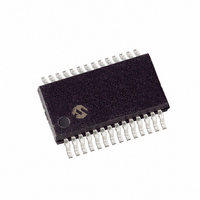PIC16F886-I/SS Microchip Technology, PIC16F886-I/SS Datasheet - Page 182

PIC16F886-I/SS
Manufacturer Part Number
PIC16F886-I/SS
Description
IC PIC MCU FLASH 8KX14 28SSOP
Manufacturer
Microchip Technology
Series
PIC® 16Fr
Datasheets
1.PIC16F616T-ISL.pdf
(8 pages)
2.MCP1631RD-MCC2.pdf
(328 pages)
3.PIC16F882-ISS.pdf
(16 pages)
4.PIC16F882-ISS.pdf
(36 pages)
5.PIC16F883-ISO.pdf
(288 pages)
Specifications of PIC16F886-I/SS
Program Memory Type
FLASH
Program Memory Size
14KB (8K x 14)
Package / Case
28-SSOP
Core Processor
PIC
Core Size
8-Bit
Speed
20MHz
Connectivity
I²C, SPI, UART/USART
Peripherals
Brown-out Detect/Reset, POR, PWM, WDT
Number Of I /o
24
Eeprom Size
256 x 8
Ram Size
368 x 8
Voltage - Supply (vcc/vdd)
2 V ~ 5.5 V
Data Converters
A/D 11x10b
Oscillator Type
Internal
Operating Temperature
-40°C ~ 85°C
Processor Series
PIC16F
Core
PIC
Data Bus Width
8 bit
Data Ram Size
368 B
Interface Type
MSSP/EUSART
Maximum Clock Frequency
20 MHz
Number Of Programmable I/os
24
Number Of Timers
3
Operating Supply Voltage
2 V to 5.5 V
Maximum Operating Temperature
+ 85 C
Mounting Style
SMD/SMT
3rd Party Development Tools
52715-96, 52716-328, 52717-734
Development Tools By Supplier
PG164130, DV164035, DV244005, DV164005, PG164120, ICE2000, DM164123, DM164120-3, DV164122
Minimum Operating Temperature
- 40 C
On-chip Adc
11-ch x 10-bit
Lead Free Status / RoHS Status
Lead free / RoHS Compliant
For Use With
DM164123 - KIT MANAGEMENT SYSTEM PICDEMAC164307 - MODULE SKT FOR PM3 28SSOPXLT28SS-1 - SOCKET TRANSITION ICE 28SSOP
Lead Free Status / Rohs Status
Lead free / RoHS Compliant
Available stocks
Company
Part Number
Manufacturer
Quantity
Price
Company:
Part Number:
PIC16F886-I/SS
Manufacturer:
MICROCHI
Quantity:
10 000
Company:
Part Number:
PIC16F886-I/SS
Manufacturer:
OKI
Quantity:
560
- PIC16F616T-ISL PDF datasheet
- MCP1631RD-MCC2 PDF datasheet #2
- PIC16F882-ISS PDF datasheet #3
- PIC16F882-ISS PDF datasheet #4
- PIC16F883-ISO PDF datasheet #5
- Current page: 182 of 288
- Download datasheet (5Mb)
PIC16F882/883/884/886/887
When the application software is expecting to receive
valid data, the SSPBUF should be read before the next
byte of data to transfer is written to the SSPBUF. The
buffer full bit BF of the SSPSTAT register indicates
when SSPBUF has been loaded with the received data
(transmission is complete). When the SSPBUF is read,
the BF bit is cleared. This data may be irrelevant if the
SPI is only a transmitter. Generally, the MSSP Interrupt
is used to determine when the transmission/reception
has completed. The SSPBUF must be read and/or
written. If the interrupt method is not going to be used,
then software polling can be done to ensure that a write
collision does not occur. Example 13-1 shows the
loading of the SSPBUF (SSPSR) for data transmission.
The SSPSR is not directly readable or writable, and
can only be accessed by addressing the SSPBUF
register. Additionally, the MSSP STATUS register
(SSPSTAT register) indicates the various status
conditions.
EXAMPLE 13-1:
DS41291D-page 180
LOOP BTFSS SSPSTAT, BF
GOTO
MOVF
MOVWF RXDATA
MOVF
MOVWF SSPBUF
LOOP
SSPBUF, W
TXDATA, W
LOADING THE SSPBUF (SSPSR) REGISTER
;Has data been received (transmit complete)?
;No
;WREG reg = contents of SSPBUF
;Save in user RAM, if data is meaningful
;W reg = contents of TXDATA
;New data to xmit
Preliminary
13.3.2
To enable the serial port, SSP Enable bit SSPEN of the
SSPCON register must be set. To reset or reconfigure
SPI mode, clear the SSPEN bit, re-initialize the
SSPCON registers, and then set the SSPEN bit. This
configures the SDI, SDO, SCK and SS pins as serial
port pins. For the pins to behave as the serial port
function, some must have their data direction bits (in
the TRIS register) appropriately programmed. That is:
• SDI is automatically controlled by the SPI module
• SDO must have TRISC<5> bit cleared
• SCK (Master mode) must have TRISC<3> bit
• SCK (Slave mode) must have TRISC<3> bit set
• SS must have TRISA<5> bit set
Any serial port function that is not desired may be
overridden by programming the corresponding data
direction (TRIS) register to the opposite value.
cleared
ENABLING SPI I/O
© 2007 Microchip Technology Inc.
Related parts for PIC16F886-I/SS
Image
Part Number
Description
Manufacturer
Datasheet
Request
R

Part Number:
Description:
IC PIC MCU FLASH 8KX14 28QFN
Manufacturer:
Microchip Technology
Datasheet:

Part Number:
Description:
IC PIC MCU FLASH 8KX14 28DIP
Manufacturer:
Microchip Technology
Datasheet:

Part Number:
Description:
IC PIC MCU FLASH 8KX14 28SOIC
Manufacturer:
Microchip Technology
Datasheet:

Part Number:
Description:
IC PIC MCU FLASH 8KX14 28DIP
Manufacturer:
Microchip Technology
Datasheet:

Part Number:
Description:
IC PIC MCU FLASH 8KX14 28SOIC
Manufacturer:
Microchip Technology
Datasheet:

Part Number:
Description:
IC PIC MCU FLASH 8KX14 28QFN
Manufacturer:
Microchip Technology
Datasheet:

Part Number:
Description:
IC,MICROCONTROLLER,8-BIT,PIC CPU,CMOS,SSOP,28PIN,PLASTIC
Manufacturer:
Microchip Technology
Datasheet:

Part Number:
Description:
Manufacturer:
Microchip Technology Inc.
Datasheet:

Part Number:
Description:
IC MCU FLASH 4KX14 EEPROM 18DIP
Manufacturer:
Microchip Technology
Datasheet:

Part Number:
Description:
IC MCU FLASH 4KX14 EEPROM 18SOIC
Manufacturer:
Microchip Technology
Datasheet:

Part Number:
Description:
IC MCU FLASH 4KX14 EEPROM 20SSOP
Manufacturer:
Microchip Technology
Datasheet:

Part Number:
Description:
IC MCU FLASH 4KX14 EEPROM 28QFN
Manufacturer:
Microchip Technology
Datasheet:

Part Number:
Description:
IC MCU FLASH 4KX14 EEPROM 18DIP
Manufacturer:
Microchip Technology
Datasheet:

Part Number:
Description:
IC,MICROCONTROLLER,8-BIT,PIC CPU,CMOS,LLCC,28PIN,PLASTIC
Manufacturer:
Microchip Technology
Datasheet:











